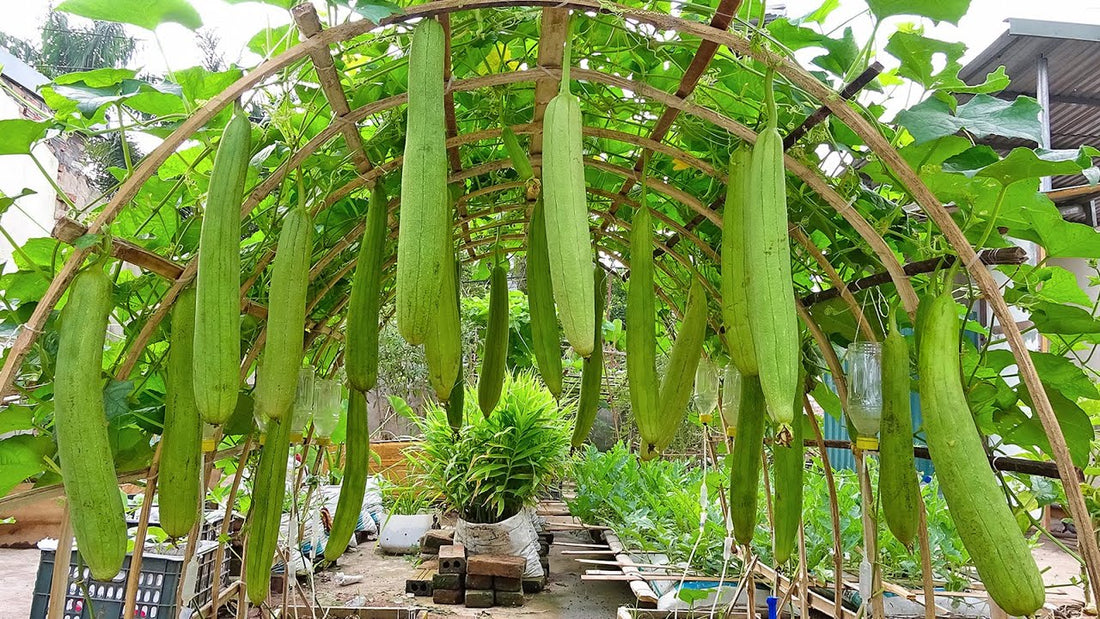
Grow Sponge Gourd in Pakistan: Moji Mall Guide
Share
Growing sponge gourd (توری) at home is simple and highly productive, especially in Pakistan’s warm climate. With a little care and enough sun, you can enjoy soft, tender toris fresh for cooking and traditional dishes. Here’s a simple step-by-step guide to grow sponge gourd successfully at home.
| Aspect | Details |
|---|---|
| Best Sowing Time | February to May |
| Ideal Temperature | 24°C to 32°C |
| Germination Time | 5–10 days |
| Transplant Time | 2–3 weeks after sowing |
| Spacing | 2–3 feet between plants |
| Harvest Time | 50–70 days after sowing |
Step 1: Sow Seeds 🌱
When to Sow:
- Sow seeds from February to May, when temperatures are warm and stable.
- Ideal soil temperature for sowing is 24°C to 32°C.
- Avoid sowing in cold or very wet soil.
How to Sow: Direct sow seeds 1 inch deep in loose, compost-rich soil. Sow 2–3 seeds together in each hole to ensure healthy sprouting.
Germination Tips: Seeds sprout in 5–10 days under warm, moist conditions. Keep the soil evenly moist but not soggy.
Step 2: Transplant Seedlings 🌿
When to Transplant: If starting in trays, transplant when seedlings have 2–3 true leaves, about 2–3 weeks after sowing.
How to Transplant: Space plants 2–3 feet apart in beds or large containers (minimum 14–16 inches wide). Provide trellis support early.
Aftercare: Water thoroughly after transplanting. Protect young plants from strong afternoon sun if needed.
Step 3: Care for Plants 🌞💧
Sunlight Needs: Sponge gourd needs 6–8 hours of direct sunlight daily for vigorous vine growth and fruiting.
Watering: Water deeply 2–3 times a week, keeping the soil moist. Increase watering slightly during flowering and fruiting stages.
Feeding Schedule: Mix compost into the soil before planting. Feed with NPK 20-20-20 fertilizer every 15 days, and switch to NPK 5-15-45 once flowering starts for better fruit production.
Step 4: Protect Plants 🐛
Common Pests: Watch for fruit flies, aphids, and red beetles feeding on leaves and flowers.
Natural Protection: Spray neem oil every 10–12 days (1 teaspoon neem oil + 1 liter water + few drops soap), focusing under leaves and near flowers.
Common Problems:
- Poor Fruit Set: Caused by poor pollination — hand-pollinate flowers early morning if needed.
- Fruit Rot: Happens when fruits stay on wet soil — mulch and train vines upward.
- Yellow Leaves: Often a sign of nutrient deficiency or overwatering.
Step 5: Harvest Gourds 🥒
When to Harvest: Sponge gourd is ready 50–70 days after sowing, when fruits are about 6–8 inches long, still soft and tender.
How to Harvest: Cut fruits with a knife or scissors, leaving a short stem attached to maintain freshness.
Bonus Tip: Harvest young tori every 2–3 days once they start appearing to keep vines productive.
FAQs
Can I grow sponge gourd in pots?
Yes, use large pots (14–16 inches wide) with strong trellis or support for vines.
How long do sponge gourd vines grow?
Vines can spread 10–15 feet or more if given space and good support.
Why are my sponge gourds turning yellow?
Overripe fruits turn yellow. Harvest while young and tender for best taste.
Why are my sponge gourd flowers falling off?
Male flowers naturally fall off. Only female flowers develop into fruits after pollination.
How often should I harvest sponge gourds?
Harvest every 2–3 days to keep vines productive and to get tender fruits.
Growing sponge gourd at home is fun and easy once you match their need for warmth, sunlight, and regular water. With just a little effort, you’ll enjoy soft, fresh toris perfect for your summer meals — much better than store-bought ones!

